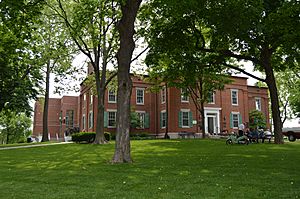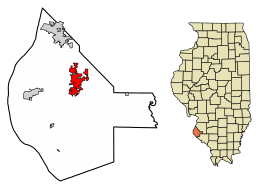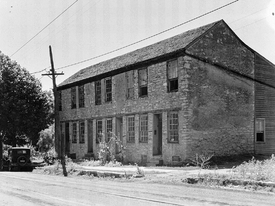Waterloo, Illinois facts for kids
Quick facts for kids
Waterloo, Illinois
|
|||
|---|---|---|---|

Monroe County Courthouse in the Waterloo Historic District
|
|||
|
|||
| Etymology: Battle of Waterloo | |||
| Motto(s):
"City Conveniences, Rural Advantages"
|
|||

Location in Monroe County, Illinois
|
|||
| Country | United States | ||
| State | Illinois | ||
| County | Monroe | ||
| Precincts | 16, 17, 18, 19, 26, and 27 | ||
| Founded | 1818 | ||
| Chartered as town | 1849 | ||
| Incorporation | 1889 | ||
| Area | |||
| • Total | 8.31 sq mi (21.53 km2) | ||
| • Land | 8.18 sq mi (21.19 km2) | ||
| • Water | 0.13 sq mi (0.35 km2) | ||
| Elevation | 717 ft (219 m) | ||
| Population
(2020)
|
|||
| • Total | 11,013 | ||
| • Density | 1,351.95/sq mi (522.02/km2) | ||
| Time zone | UTC-6 (CST) | ||
| • Summer (DST) | UTC-5 (CDT) | ||
| ZIP code |
62298
|
||
| Area code(s) | 618 | ||
| FIPS code | 17-79150 | ||
Waterloo is a city in Monroe County, Illinois, USA. It is the main city, or "county seat," of Monroe County. In 2020, about 11,013 people lived there. This was more than the 9,811 people who lived there in 2010.
Contents
Geography and Location of Waterloo
Waterloo is located in the northeast part of Monroe County. It is about 24 miles (39 km) north of downtown St. Louis.
Illinois Route 3 runs through the west side of the city. This road goes north to Columbia (about 8 miles or 13 km away). It also goes southeast to Red Bud (about 13 miles or 21 km away).
Illinois Route 156 also passes through Waterloo. It leads to Hecker (about 9 miles or 14 km east) and Valmeyer (about 7 miles or 11 km west).
Land and Water in Waterloo
Waterloo covers about 8.31 square miles (21.53 square kilometers). Most of this area is land (8.18 sq mi or 21.19 sq km). A small part, about 0.13 square miles (0.35 sq km), is water.
The city is on a ridge, which is like a raised line of land. Water from this ridge flows in two directions:
- East, into streams that join Prairie du Long Creek. This creek flows into the Kaskaskia River.
- West, into streams that join Fountain Creek. This creek flows directly into the Mississippi River.
Waterloo is also located along an old path. This path was used for travel between Kaskaskia and St. Louis a long time ago.
History of Waterloo
Waterloo has a long history, going back to the 1700s.
Early French and British Times
The first Europeans to settle here were the French. They arrived in the 18th century. They chose this spot because it was on high ground. This was important because the nearby Mississippi River Valley often flooded the lower areas. The settlement was also close to Fort de Chartres, a strong French fort.
The French called their settlement Bellefontaine, which means "beautiful spring." This name came from a spring of water about a mile south of the town. This spring was a popular resting spot for travelers going between Kaskaskia, Cahokia, and St. Louis.
France later gave this land to Britain in 1763 after the Seven Years' War. The area was then left empty for a while.
After the Revolutionary War
The first English-speaking settlers arrived in 1782. James Moore, Larken Rutherford, and James Garretson came from Maryland and Virginia. They were the first permanent English-speaking settlers in the entire Northwest Territory.
James Moore settled near the spring that gave Bellefontaine its name. His family owned this land for over 100 years. The kitchen of the Bellefontaine House is thought to be Moore's original log cabin. It has been fixed up and is now a local landmark.
Other settlers, like Judge Shadrach Bond, also came. He was the uncle of Shadrach Bond, who became Illinois' first governor. The new settlers soon felt threatened by Native Americans. James Moore was chosen to lead a group to protect the colony.
At that time, Illinois was part of Virginia. So, Captain Moore received his orders from Virginia's governor, Patrick Henry. Moore was told to build a military post and lead the local militia. A fort, or blockhouse, was built at Bellefontaine. During the Northwest Indian War, it was a safe place for many people.
Captain Moore worked hard to make peace with the Native Americans. With help from Gabriel Cerré, a merchant from St. Louis, he made a trade agreement. One of Moore's sons, James B. Moore, helped write the first Illinois Constitution. He was also elected to the State Legislature.
By 1800, Bellefontaine had 286 people. This made it the third-largest town in Illinois. It held more than a tenth of the total population of the territory back then.
The Peterstown Area
In 1816, Emery Peters Rogers came to the area from Massachusetts. Four years later, he opened the first permanent store, a mill, and a quarry. In 1830, Peters built a stone building at the north end of Main Street. This building was his store and a stop for stagecoaches. It is now called the Peterstown House and is still standing. It was added to the National Register of Historic Places in 1977.
Because of Peters' influence, the area around his store became known as "Peterstown." Over time, the town had two parts: Bellefontaine in the south and Peterstown in the north. A creek divided the two communities, and there was a strong rivalry between them.
A story says that in 1818, an Irishman named Charles Carroll arrived. He ignored the rivalry and built his house on one side of the creek and his barn on the other. He then said, "It won't be Bellefontaine, and it won't be Peterstown, but begorra, I'll give ye's both your Waterloo." This is how the town got its current name.
Emery Peters Rogers' brother, Dr. John Rogers, arrived in 1826. He became a leading doctor in the area. In 1825, Waterloo was named the county seat. David H. Ditch's log home, which had become a hotel, was turned into a courthouse. By 1836, the town had about twenty buildings. These included a small brick courthouse, a Methodist church, a log schoolhouse, a wind-powered mill, and a blacksmith's shop.
Many important people lived in Waterloo during the 1800s. George Forquer bought a lot of land in 1818. He worked with Daniel P. Cook to plan the growing town. Forquer later became an Illinois state senator and the fifth Secretary of State of Illinois. He was also an early political opponent of Abraham Lincoln. Cook was a well-known lawyer and a member of Congress. Cook County is named after him. Forquer's younger half-brother, Thomas Ford, became the state's governor.
German Settlers in the 1800s
Waterloo's population grew a lot after 1840, especially with German immigrants. Some came from older German communities in America. Many others came directly from Germany. They traveled overland from East Coast ports or upriver from New Orleans. They were looking for their own land and wanted to escape political problems in Germany at the time.
Today, many of the city's buildings, its people, and its local culture still show the influence of these German settlers. You can still hear some German words and phrases in everyday conversations.
Waterloo Becomes a City
Waterloo officially became a town on February 12, 1849. It was later chartered as a city on August 29, 1888.
Waterloo in the 20th Century
In 1978, the Waterloo Historic District was recognized. It was added to the National Register of Historic Places.
Waterloo also has a special connection with a city in Germany through Sister Cities International. On October 2, 1980, Waterloo became a sister city with Porta Westfalica in West Germany. This happened because people found that many German families in Monroe County could trace their roots back to this part of northern Germany.
Porta Westfalica was formed in 1973 by combining 15 villages. It is located on the Weser River in northern Germany. Large groups from Waterloo often visit Porta Westfalica every two years. The Waterloo German Band and Porta's youth brass band, the Bläserkreis, have exchanged visits. This partnership, called "Portaloo," has helped other nearby communities create their own Sister Cities programs. "Portaloo" has won seven Reader's Digest awards for its program. Every summer, Waterloo holds an event called "Porta Westfalica Fest" or "PortaFest" to celebrate this special friendship.
In 2017, Safewise.com named Waterloo the 12th Safest City in America for cities with over 10,000 people.
Population Changes in Waterloo
Waterloo has grown steadily over the years. Here's how its population has changed:
| Historical population | |||
|---|---|---|---|
| Census | Pop. | %± | |
| 1850 | 791 | — | |
| 1860 | 1,435 | 81.4% | |
| 1870 | 1,537 | 7.1% | |
| 1880 | 1,802 | 17.2% | |
| 1890 | 1,860 | 3.2% | |
| 1900 | 2,114 | 13.7% | |
| 1910 | 2,091 | −1.1% | |
| 1920 | 1,930 | −7.7% | |
| 1930 | 2,239 | 16.0% | |
| 1940 | 2,361 | 5.4% | |
| 1950 | 2,821 | 19.5% | |
| 1960 | 3,739 | 32.5% | |
| 1970 | 4,546 | 21.6% | |
| 1980 | 4,646 | 2.2% | |
| 1990 | 5,072 | 9.2% | |
| 2000 | 7,614 | 50.1% | |
| 2010 | 9,811 | 28.9% | |
| 2020 | 11,013 | 12.3% | |
| U.S. Decennial Census | |||
In 2000, there were 7,614 people living in Waterloo. Most people (98.78%) were White. About 0.68% of the population were Hispanic or Latino.
The average household had 2.53 people. The average family had 3.05 people. About 26.1% of the population was under 18 years old. The median age was 36 years.
Schools in Waterloo
Waterloo has several public and private schools. All public schools are part of the Waterloo Community Unit District #5.
Elementary Schools
- Zahnow Elementary School (Public, grades K–1)
- Rogers Elementary School (Public, grades 2–3)
- Gardner Elementary School (Public, grades 4–5)
- SS Peter and Paul Grade School (Catholic, grades K–8)
Junior High School
- Waterloo Junior High School (Public, grades 6–8)
High Schools
- Waterloo High School (Public)
- Gibault Catholic High School (Catholic)
In total, schools in Waterloo had 3,284 students and 210 teachers.
Historic Places in Waterloo
Here are some places in and around Waterloo that are listed on the National Register of Historic Places:
- Capt. James Moore Farmstead
- Fountain Creek Bridge (just west of the city)
- Peterstown House
- Waterloo Historic District (Illinois)
Climate in Waterloo
Waterloo has a climate with hot, humid summers. Winters are generally cool. This type of weather is called a humid subtropical climate.
Famous People from Waterloo
- Albert Bollinger: An Illinois state senator, lawyer, and businessman.
- Lee Eilbracht: A great baseball player and coach at the University of Illinois.
- Olga Hartman: A zoologist who studied polychaete worms. She was born in Waterloo.
- Thomas B. Needles: An Illinois politician and businessman, also born in Waterloo.
- Alexandra Kay: A country singer who grew up in Waterloo.
Images for kids
See also
 In Spanish: Waterloo (Illinois) para niños
In Spanish: Waterloo (Illinois) para niños







